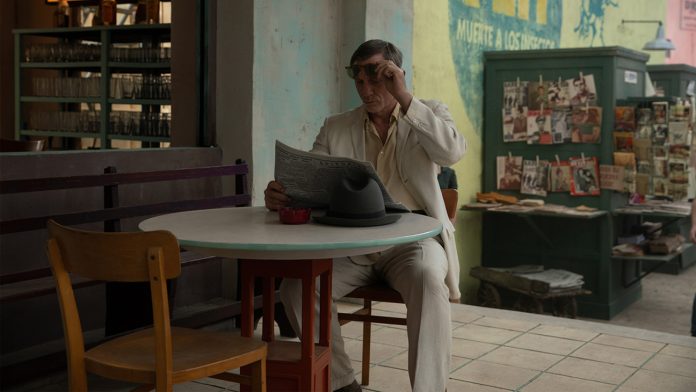The jazzy experimental style of the Beat Generation writers has made their work notoriously tricky to adapt for the screen. Walter Salles’ On the Road, Rob Epstein and Jeffrey Friedman’s Howl and David Cronenberg’s Naked Lunch took stabs at it with varying degrees of success. John Krokidas’ under-appreciated Kill Your Darlings arguably came closer to capturing the rebellious energy of the literary movement by tracing a formative episode in the lives of the writers themselves. In Queer, Luca Guadagnino meets William S. Burroughs on the iconoclast’s own slippery terms and the result is mesmerizing.
Working again with Justin Kuritzkes, his screenwriter on Challengers, Guadagnino paints an evocative picture of ex-pat ennui in post-World War II Mexico City, establishing the foundations of a love story grounded in realism before shifting into fantasy as the narrative becomes a drug-addled mosaic. The film was acquired ahead of its Venice premiere by A24, which is planning a release later this year.
Queer
The Bottom Line
Drifts hypnotically between realism and hallucination.
Venue: Venice Film Festival (Competition)
Cast: Daniel Craig, Drew Starkey, Jason Schwartzman, Lesley Manville
Director: Luca Guadagnino
Screenwriter: Justin Kuritzkes, based on the novel by William S. Burroughs
2 hours 15 minutes
Written in the early ‘50s while Burroughs was awaiting trial for the allegedly accidental homicide of his common-law wife, Joan Vollmer, but not published until 1985, the novel is practically a memoir, given how closely it hews to events in the author’s diaries and letters.
The book sits squarely between Junkie and Naked Lunch in chronicling the experiences with opioid addiction of Burroughs’ alter ego, William Lee. But Queer perhaps is the most revealing of the three books about the writer himself, depicting Lee’s unraveling, possessed by desire and corrosive need. The object of that obsession is Eugene Allerton, a fresh-faced American ex-military kid inspired by Adelbert Lewis Marker, who was 21 when he and Burroughs met.
It’s hard to think of a more ideal director than Guadagnino to explore queerness, sensuality and the shifting terrain of romantic intoxication, and he’s found the perfect traveling companion in Daniel Craig. In a transfixing performance that balances colorful affectation with raw hunger, the actor makes Lee a magnetic raconteur whose shield of worldly composure falls away as Eugene (Drew Starkey) eludes his grasp, leaving him a virtual ghost by the end of the film.
In Mexico City to escape charges of heroin possession in the U.S., Lee indulges his drug habit with whatever he can get, while trying to write but more often spending time strolling the streets, drinking in a charged atmosphere of brothels and cock fights and bars captured in granular panoramic splendor by DP Sayombhu Mukdeeprom.
Aside from some second-unit work, the movie was shot entirely at Cinecittà, with sets constructed on the historic Rome studio backlot. (Queer marks the second major film this year to recreate Mexico on European soundstages, following Jacques Audiard’s Emilia Pérez.)
Lee is a fixture at the Ship Ahoy bar, floating among the queer American ex-patriate community but maintaining a real friendship seemingly only with Joe, who’s unwilling to give up his taste for rough trade over anything as inconsequential as getting assaulted or robbed. Played by an unrecognizable Jason Schwartzman, Joe could almost be an Allen Ginsberg surrogate, spinning low-key hilarious accounts of his sexual adventures. When a dalliance with a cop turns sour and he finds “El Puto Gringo” scrawled on an exterior wall of his home, he shrugs, “I left it there. It pays to advertise.”
Lee pulls his share of young tricks, both Americans and Mexicans, but when lanky, bespectacled Eugene catches his eye on the street, he’s bewitched. At first, their flirtatious glances are a playful cat-and-mouse game. Lee strikes out in his initial attempts to connect, but Eugene gradually starts fraternizing with him at bars.
They go to a movie theater to see Cocteau’s Orpheus, where Guadagnino finds a gorgeous visual translation for Burroughs’ description of Lee as he imagines caressing and kissing Eugene, with “ectoplasmic fingers” and “phantom thumbs.” Also lifted directly from the novel is a moving image soon after, when Lee in his mind leans in close to the younger man, appearing “curiously spectral, as though you could see through his face.”
Though the connection does eventually extend to the physical, it’s more a question of Lee servicing Eugene and the latter surprising him by reciprocating, albeit with impersonal detachment. While Eugene is sufficiently bi-curious to express interest in the gay bars around town, there’s no indication that he’s had sex with men before, or that he enjoys it. But Lee perseveres, convincing him to accompany him to South America, covering all costs and bargaining for intimacy once or twice a week.
Burroughs purists might scoff, but it lends credibility and warmth to the trajectory of this transactional relationship that Guadagnino and Kuritzkes have sanded down some of Lee’s more abrasive edges from the novel — his patronizing attitudes toward Mexicans for one. Craig looks both seedy and elegant, louche and dashing in his linen suits and fedora. You can understand a youth being dazzled by Lee’s “routines,” flavorful anecdotes full of seductive conversational flourishes.
While Craig makes this loquacious side of the character highly entertaining, he’s also superb at showing Lee’s unaccustomed self-exposure, his aching need for human contact increasing his vulnerability as his addiction to Eugene becomes chronic. With illuminating new self-knowledge comes crippling weakness, something Craig fully conveys in a ballsy performance covering a broad psychological and emotional spectrum.
Once they depart Mexico, drug withdrawals leave Lee weak and shivering, clinging to every tenuous sign that Eugene cares for him. Playing a withholding character, Starkey deftly keeps an air of mystery around that question though he never risks being perceived as a mere user. Despite being ambivalent about the sex, his irritation is tempered by compassion for hopelessly consumed Lee. The actor quietly sizzles in the high-waisted trousers and knit shirts of the time; Eugene wears his preppy wardrobe with a natural panache about which he seems oblivious.
The purpose of the South America trip is to find a plant-derived hallucinogen called yagé, more commonly known as ayahuasca, which Lee believes can trigger powers of telepathic divination. This takes them into the Ecuadorian jungle to meet wildly eccentric, stringy-haired American botanist Dr. Cotter, who lives in a hut with her younger male companion (Argentinian director Lisandro Alonso) and a sloth. (Another of Guadagnino’s directing contemporaries, David Lowery, appears earlier as one of Lee’s bar acquaintances.)
The botanist is played to the hilt by Lesley Manville (also unrecognizable), feral and ferocious, packing a pistol lest anyone try to make off with her precious research material. Lee assures her in his disarming way that they just want to sample the brew, which she warns them is a mirror, not a portal to another place.
Psychedelic tripping scenes in movies often tend to be embarrassing. But Guadagnino knows what he’s doing, folding together body horror elements reminiscent of his Suspiria remake — if you want to see two men literally vomit up their hearts, you’re in the right place — with an almost balletic union between Lee and Eugene that’s as spiritual as it is carnal.
Cotter encourages them to stick around and see where more of the drug could take them, but they decline. As they leave, she tells Eugene: “The door is already open. You can’t close it.” Those cryptic words hang in the air of a haunting epilogue with Lee back in Mexico City two years later, in which the images of Eugene in his head become enmeshed with Burroughs’ own traumatic history with Vollmer.
This is Guadagnino’s fourth collaboration with gifted Thai cinematographer Mukdeeprom; it’s heady and beautiful, finding dreamy visual poetry even in tawdriness and squalor. The air seems pervaded by palpable strains of both sensuality and desolation. The period production and costume design (respectively Stefano Baisi and Jonathan Anderson) clearly have been meticulously curated but have a lived-in feel that gives the movie as much grit as elegance.
After their pounding beats energized Challengers, Trent Reznor and Atticus Ross shift gears with a score drenched in melancholy feeling, shaping the mood along with invigorating blasts of non-period tracks by New Order, Nirvana, Sinéad O’Connor and Prince, among others. Those bold choices are typical of Guadagnino’s sure hand throughout this strange, beguiling film, fueled by tenderness, loneliness, lust and swooning unrequited love.







